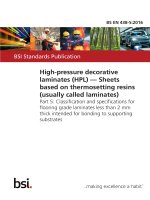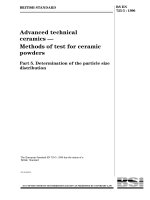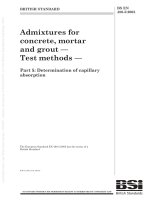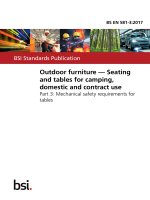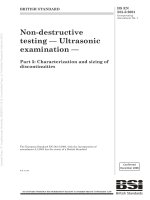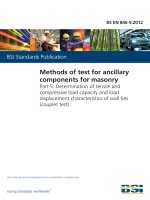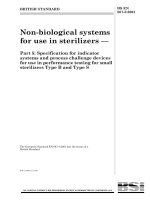Bsi bs en 10222 5 2017
Bạn đang xem bản rút gọn của tài liệu. Xem và tải ngay bản đầy đủ của tài liệu tại đây (1.11 MB, 34 trang )
BS EN 10222-5:2017
BSI Standards Publication
Steel forgings for pressure purposes
Part 5: Martensitic, austenitic and austenitic-ferritic stainless steels
BS EN 10222‑5:2017
BRITISH STANDARD
National foreword
This British Standard is the UK implementation of EN 10222-5:2017.
It supersedes BS EN 10222-5:2000, which is withdrawn.
The UK participation in its preparation was entrusted to Technical
Committee ISE/111, Steel Castings and Forgings.
A list of organizations represented on this committee can be obtained on
request to its secretary.
This publication does not purport to include all the necessary provisions
of a contract. Users are responsible for its correct application.
ISBN 978 0 580 80528 8
ICS 77.140.30; 77.140.85
Compliance with a British Standard cannot confer immunity from
legal obligations.
This British Standard was published under the authority of the
Standards Policy and Strategy Committee on 31 May 2017.
Amendments/corrigenda issued since publication
Date
Text affected
BS EN 10222‑5:2017
EN 10222-5
EUROPEAN STANDARD
NORME EUROPÉENNE
EUROPÄISCHE NORM
April 2017
ICS 77.140.30; 77.140.85
Supersedes EN 10222-5:1999
English Version
Steel forgings for pressure purposes - Part 5: Martensitic,
austenitic and austenitic-ferritic stainless steels
Pièces forgées en acier pour appareils à pression Partie 5: Aciers inoxydables austénitiques
martensitiques et austénoferritiques
Schmiedestücke aus Stahl für Druckbehälter - Teil 5:
Martensitische, austenitische und austenitischeferritisch nichtrostende Stähle
This European Standard was approved by CEN on 25 December 2016.
CEN members are bound to comply with the CEN/CENELEC Internal Regulations which stipulate the conditions for giving this
European Standard the status of a national standard without any alteration. Up-to-date lists and bibliographical references
concerning such national standards may be obtained on application to the CEN-CENELEC Management Centre or to any CEN
member.
This European Standard exists in three official versions (English, French, German). A version in any other language made by
translation under the responsibility of a CEN member into its own language and notified to the CEN-CENELEC Management
Centre has the same status as the official versions.
CEN members are the national standards bodies of Austria, Belgium, Bulgaria, Croatia, Cyprus, Czech Republic, Denmark, Estonia,
Finland, Former Yugoslav Republic of Macedonia, France, Germany, Greece, Hungary, Iceland, Ireland, Italy, Latvia, Lithuania,
Luxembourg, Malta, Netherlands, Norway, Poland, Portugal, Romania, Serbia, Slovakia, Slovenia, Spain, Sweden, Switzerland,
Turkey and United Kingdom.
EUROPEAN COMMITTEE FOR STANDARDIZATION
C O M I TÉ E URO P É E N D E N O RM ALI SATI O N
E U RO P ÄI S C H E S KO M I T E E F Ü R N O RM U N G
CEN-CENELEC Management Centre: Avenue Marnix 17, B-1000 Brussels
© 2017 CEN
All rights of exploitation in any form and by any means reserved
worldwide for CEN national Members.
Ref. No. EN 10222-5:2017 E
BS EN 10222‑5:2017
EN 10222-5:2017 (E)
Contents
Page
European foreword ....................................................................................................................................................... 3
1
Scope .................................................................................................................................................................... 4
2
Normative references .................................................................................................................................... 4
3
Terms and definitions ................................................................................................................................... 4
4
4.1
4.2
Classification and designation .................................................................................................................... 4
Classification ..................................................................................................................................................... 4
Designation........................................................................................................................................................ 4
5
5.1
5.2
Information to be supplied by the purchaser ....................................................................................... 5
Mandatory information ................................................................................................................................ 5
Options ................................................................................................................................................................ 5
6
6.1
6.2
6.3
6.3.1
6.3.2
6.3.3
6.4
6.5
6.6
6.7
6.8
Requirements ................................................................................................................................................... 5
Steelmaking process and manufacture of the product...................................................................... 5
Delivery condition .......................................................................................................................................... 5
Chemical composition and chemical corrosion properties ............................................................. 5
Cast analysis ...................................................................................................................................................... 5
Product analysis .............................................................................................................................................. 5
Resistance to intergranular corrosion .................................................................................................... 5
Mechanical properties ................................................................................................................................... 6
Surface condition ............................................................................................................................................ 6
Internal soundness ......................................................................................................................................... 6
Physical properties ......................................................................................................................................... 6
Post weld heat treatment ............................................................................................................................. 6
7
Inspection .......................................................................................................................................................... 6
8
Sampling ............................................................................................................................................................. 6
9
Test methods .................................................................................................................................................... 6
10
Retests ................................................................................................................................................................. 6
11
Marking ............................................................................................................................................................... 6
Annex A (informative) Reference data for creep rupture strength ........................................................ 20
Annex B (informative) Post weld heat treatment.......................................................................................... 25
Annex C (informative) Significant technical changes to the version EN 10222-5:1999 .................. 27
Annex ZA (informative) Relationship between this European Standard and the Essential
Requirements of EU Directive 2014/68/EU ....................................................................................... 28
Bibliography ................................................................................................................................................................. 29
2
BS EN 10222‑5:2017
EN 10222-5:2017 (E)
European foreword
This document (EN 10222-5:2017) has been prepared by Technical Committee ECISS/TC 111 “Steel
castings and forgings”, the secretariat of which is held by AFNOR.
This European Standard shall be given the status of a national standard, either by publication of an
identical text or by endorsement, at the latest by October 2017, and conflicting national standards shall
be withdrawn at the latest by October 2017.
Attention is drawn to the possibility that some of the elements of this document may be the subject of
patent rights. CEN shall not be held responsible for identifying any or all such patent rights.
This document supersedes EN 10222-5:1999.
This document has been prepared under a mandate given to CEN by the European Commission and the
European Free Trade Association, and supports essential requirements of EU Directive 2014/68/EU.
For relationship with EU Directive 2014/68/EU, see informative Annex ZA, which is an integral part of
this document.
EN 10222 consists of the following parts under the general title “Steel forgings for pressure purposes”:
— Part 1 : General requirements for open die forgings
— Part 2: Ferritic and martensitic steels with specified elevated temperature properties
— Part 3: Nickel steels with specified low temperature properties
— Part 4: Weldable fine grain steels with high proof strength
— Part 5: Martensitic, austenitic and austenitic-ferritic stainless steels.
Annex C provides details about significant technical changes to EN 10222-5:1999.
According to the CEN-CENELEC Internal Regulations, the national standards organisations of the
following countries are bound to implement this European Standard: Austria, Belgium, Bulgaria,
Croatia, Cyprus, Czech Republic, Denmark, Estonia, Finland, Former Yugoslav Republic of Macedonia,
France, Germany, Greece, Hungary, Iceland, Ireland, Italy, Latvia, Lithuania, Luxembourg, Malta,
Netherlands, Norway, Poland, Portugal, Romania, Serbia, Slovakia, Slovenia, Spain, Sweden, Switzerland,
Turkey and the United Kingdom.
3
BS EN 10222‑5:2017
EN 10222-5:2017 (E)
1 Scope
This European Standard specifies the technical delivery conditions for forgings for pressure purposes,
made of stainless steels, including creep resisting steels. Chemical composition and mechanical
properties are specified.
NOTE
Once this standard is published in the EU Official Journal (OJEU) under Directive 2014/68/EU,
presumption of conformity to the Essential Safety Requirements (ESRs) of Directive 2014/68/EU is limited to
technical data of materials in this standard and does not presume adequacy of the material to a specific item of
equipment. Consequently, the assessment of the technical data stated in this material standard against the design
requirements of this specific item of equipment to verify that the ESRs of Directive 2 014/68/EU are satisfied,
needs to be done. The series EN 10222–1 to EN 1022 2 − 5 is structured so that the data related to different
materials is in the part allocated for that material. The presumption of conformity to the Essential Safety
Requirements of Directive 2 014/68/EU depends on both the text in part 1 and the data in part 2, 3, 4 or 5.
General information on technical delivery conditions is given in EN 10021.
2 Normative references
The following documents, in whole or in part, are normatively referenced in this document and are
indispensable for its application. For dated references, only the edition cited applies. For undated
references, the latest edition of the referenced document (including any amendments) applies.
EN 10088-1:2014, Stainless steels - Part 1 : List of stainless steels
EN 10222-1:2017, Steel forgings for pressure purposes — Part 1 : General requirements for open die
forgings
EN ISO 3651-2:1998, Determination of resistance to intergranular corrosion of stainless steels - Part 2:
Ferritic, austenitic and ferritic-austenitic (duplex) stainless steels - Corrosion test in media containing
sulfuric acid (ISO 3651 -2:1 998)
3 Terms and definitions
For the purpose of this document, the terms and definitions given in EN 10222-1:2017 apply.
4 Classification and designation
4.1 Classification
The steel grades covered in this document are classified according to their structure into:
— martensitic steels;
— austenitic steels;
— austenitic-ferritic steels.
NOTE
For more details see EN 10088–1.
4.2 Designation
See EN 10222-1:2017.
4
BS EN 10222‑5:2017
EN 10222-5:2017 (E)
5 Information to be supplied by the purchaser
5.1 Mandatory information
Shall be in accordance with EN 10222-1.
5.2 Options
A number of options are specified in this European Standard and listed below. Additionally the relevant
options of EN 10222-1 apply. If the purchaser does not give any information to implement any of these
options at the time of enquiry and order, the products shall be supplied in accordance with the basic
specification (see also EN 10222-1).
1)
test temperature for the tensile test at elevated temperature, if applicable (see 6.4.3);
2)
test temperature of the impact test at low temperature (see 6.4.4);
3)
controlled sulphur content (see Table 2, footnote b).
6 Requirements
6.1 Steelmaking process and manufacture of the product
Shall be in accordance with EN 10222-1.
6.2 Delivery condition
The products shall be delivered in the heat treatment condition specified in Table 1.
6.3 Chemical composition and chemical corrosion properties
6.3.1 Cast analysis
The chemical composition (cast analysis), determined in accordance with EN 10222-1 shall conform to
the requirements of Table 2.
6.3.2 Product analysis
The product analysis shall not deviate from the specified cast analysis (see 6.3.1) by more than the
values specified in Table 3.
6.3.3 Resistance to intergranular corrosion
The specifications in Table 4 apply in respect to resistance to intergranular corrosion as defined in
EN ISO 3651-2, for austenitic and austenitic-ferritic steels.
See EN 10222-1:2017, 9.9, Table 1.
NOTE 1
EN ISO 3651-2 is not applicable for testing martensitic steels.
NOTE 2
The corrosion resistance of stainless steels is very dependent on the type of environment and can
therefore not always be clearly as certained through laboratory tests. It is therefore advisable to draw on the
available experience of the use of the steels.
5
BS EN 10222‑5:2017
EN 10222-5:2017 (E)
6.4 Mechanical properties
6.4.1
When heat treated in accordance with Table 1, the mechanical properties shall conform to the
requirements of Table 4.
Elevated temperature proof strength (Rp0,2 and Rp1,0 ) values shall conform to the requirements
of Table 5 and Table 6. Elevated temperature tensile strength (Rm) values shall conform to Table 7.
6.4.2
6.4.3 If verification of specified proof strength at elevated temperature is requested (see
EN 10222-1:2017, Table 1), the testing temperature should be agreed at the time of enquiry and order.
Otherwise, the test shall be carried out at 300 °C, except for the austenitic-ferritic steels, where the test
shall be carried out at 250 °C.
6.4.4 The impact test, if applicable (see EN 10222-1:2017, Table 1), shall be carried out at 20 °C.
Where impact tests at low temperature have been agreed (see EN 10222-1:2017, Table 1), the test
temperature shall also be agreed at the time of enquiry and order.
6.4.5
Reference data for 1 % (plastic) creep strain and creep rupture are given in Annex A.
6.5 Surface condition
See EN 10222-1.
6.6 Internal soundness
See EN 10222-1.
6.7 Physical properties
For reference data on physical properties, see EN 10088-1:2014, Annex E.
6.8 Post weld heat treatment
Guidelines for the purchaser on post weld heat treatment are given in Annex B.
7 Inspection
See EN 10222-1.
8 Sampling
See EN 10222-1.
9 Test methods
See EN 10222-1.
10 Retests
See EN 10222-1.
11 Marking
See EN 10222-1.
6
BS EN 10222‑5:2017
EN 10222-5:2017 (E)
Table 1 — Heat treatment
Steel grade
Steel name
Steel number
Heat
treatmenta
Solution
annealing
°C
Cooling in b
Martensitic steel
X3CrNiMo13–4
1.4313
+QT or +T
950 to 1 050
a, o c
+QT
(for quenching)
a, o d
Austenitic steels e
X2CrNi18–9
1.4307
+AT
1 025 to 1 100
w, a
X2CrNi19–11
1.4306
+AT
1 000 to 1 100
w, a
X2CrNiN18–10
1.4311
+AT
1 000 to 1 100
w, a
X5CrNi18–10
1.4301
+AT
1 000 to 1 100
w, a
X6CrNiTi18–10
1.4541
+AT
1 020 to 1 120
w, a
X6CrNiNb18–10
1.4550
+AT
1 020 to 1 120
w, a
X6CrNi18–10
1.4948
+AT
1 050 to 1 120
w, a
X6CrNiTiB18–10
1.4941
+AT
1 070 to 1 140
w, a
X7 CrNiNb18–10
1.4912
+AT
1 070 to 1 125
w, a
X2CrNiMo17–12–2
1.4404
+AT
1 020 to 1 120
w, a
X2CrNiMoN 17–11–2
1.4406
+AT
1 020 to 1 120
w, a
X5CrNiMo17–12–2
1.4401
+AT
1 020 to 1 120
w, a
X6CrNiMoTi 17–12–2
1.4571
+AT
1 020 to 1 120
w, a
X2 CrNiMo17–12–3
1.4432
+AT
1 020 to 1 120
w, a
X2CrNiMoN 17–13–3
1.4429
+AT
1 020 to 1 120
w, a
X3CrNiMo17–13–3
1.4436
+AT
1 020 to 1 120
w, a
X2CrNiMo18–14–3
1.4435
+AT
1 020 to 1 120
w, a
X3CrNiMoN17–13–3
1.4910
+AT
1 020 to 1 100
w, a
X2CrNiMoN17–13–5
1.4439
+AT
1 060 to 1 120
w, a
X1NiCrMoCu2 5–20–5
1.4539
+AT
1 060 to 1 120
w, a
X1CrNiMoCuN20–18–
7
1.4547
+AT
1 020 to 1 120
w, a
X1CrNiMoCuN25–20–
7
1.4529
+AT
1 020 to 1 100
w, a
X2CrNiCu19–10
1.4650
+AT
1 050 to 1 125
w, a
X3CrNiMo18–12–3
1.4449
+AT
1 050 to 1 125
w, a
7
BS EN 10222‑5:2017
EN 10222-5:2017 (E)
Steel grade
Steel name
Steel number
Solution
annealing
Heat
treatmenta
°C
Cooling inb
Austenitic-ferritic steels e
X2CrNiN23–4
1.4362
+AT
950 to 1 100
w, a
X2CrNiMoN22–5–3
1.4462
+AT
1 020 to 1 100
–
X2CrNiMoCuN25–6–3
1.4507
+AT
1 040 to 1 120
w, a
X2CrNiMoN25–7–4
1.4410
+AT
1 040 to 1 120
w, a
X2CrNiMoCuWN25–
7–4
1.4501
+AT
1 040 to 1 120
w, a
a
+AT solution annealed, +T tempered, +QT quenched and tempered.
b
a = air ; o = oil ; w = water or water based medium.
c
Double tempered at 600 °C to 620 °C.
d
Tempered at 570 °C to 600 °C.
e
The solution treatment may be omitted if the conditions for hot working and subsequent cooling are
such that the requirements for the mechanical properties of the product and the resistance to intergranular
corrosion as defined in EN ISO 3651-2 are obtained and provided these requirements are met even after
appropriate subsequent solution annealing.
8
EN 10222-5:2017 (E)
Table 2 — Chemical composition (cast analysis) a
Steel grade
Steel name
% by mass
Steel
number
C
Si
max.
Mn
max.
P
max.
S
max.
Cr
Mo
Ni
N
Others
12,0 to 14,0
0,30 to
0,70
3,5 to 4,5
≥ 0,020
–
Martensitic steels
X3CrNiMo13–4
1.4313
≤ 0,05
0,70
1,50
0,040
0,015
Austenitic steels
1.4307
≤ 0,030
1,00
2,00
0,045
0,015 b
17,5 to 19,5
–
8,0 to 10,5
≤ 0,10
–
X2CrNi19–11
1.4306
≤ 0,030
1,00
2,00
0,045
0,015 b
18,0 to 20,0
–
10,0 to 12,0
≤ 0,10
–
X2CrNiN18–10
1.4311
≤ 0,030
1,00
2,00
0,045
0,015 b
17,5 to 19,5
–
8,5 to 11,5
0,12 to
0,22
–
X5CrNi18–10
1.4301
≤ 0,07
1,00
2,00
0,045
0,015 b
17,5 to 19,5
–
8,0 to 10,5
≤ 0,10
–
X6CrNiTi18–10
1.4541
≤ 0,08
1,00
2,00
0,045
0,015 b
17,0 to 19,0
–
9,0 to 12,0
–
Ti:5 x C to 0,70
X6CrNiNb18–10
1.4550
≤ 0,08
1,00
2,00
0,045
0,015 b
17,0 to 19,0
–
9,0 to 12,0
–
Nb:10 x C to
1,00
X6CrNi18–10
1.4948
0,04 to
0,08
1,00
2,00
0,035
0,015 b
17,0 to 19,0
–
8,0 to 11,0
≤ 0,10
–
X6CrNiTiB18–10
1.4941
0,04 to
0,08
1,00
2,00
0,035
0,015 b
17,0 to 19,0
–
9,0 to 12,0
–
Ti: 5 x C to 0,80
B:0,0015 to
0,0050
X7CrNiNb18–10
1.4912
0,04 to
0,10
1,00
2,00
0,045
0,015 b
17,0 to 19,0
–
9,0 to 12,0
–
Nb:10 x C to
1,20
X2CrNiMo17–12–2
1.4404
≤ 0,030
1,00
2,00
0,045
0,015 b
16,5 to 18,5
2,00 to
2,50
10,0 to 13,0
≤ 0,10
–
X2CrNiMoN17–11–2
1.4406
≤ 0,030
1,00
2,00
0,045
0,015 b
16,5 to 18,5
2,00 to
2,50
10,0 to 12,5
0,12 to
0,22
–
9
BS EN 10222‑5:2017
X2CrNi18–9
Steel grade
% by mass
Steel
number
C
Si
max.
Mn
max.
P
max.
S
max.
Cr
Mo
Ni
N
Others
X5CrNiMo17–12–2
1.4401
≤ 0,07
1,00
2,00
0,045
0,015 b
16,5 to 18,5
2,00 to
2,50
10,0 to 13,0
≤ 0,10
–
X6CrNiMoTi17–12–2
1.4571
≤ 0,08
1,00
2,00
0,045
0,015 b
16,5 to 18,5
2,00 to
2,50
10,5 to 13,5
–
Ti:5 x C to 0,70
X2CrNiMo17–12–3
1.4432
≤ 0,030
1,00
2,00
0,045
0,015 b
16,5 to 18,5
2,50 to
3,00
10,5 to 13,0
≤ 0,10
–
X2CrNiMoN17–13–3
1.4429
≤ 0,030
1,00
2,00
0,045
0,015 b
16,5 to 18,5
2,50 to
3,00
11,0 to 14,0
0,12 to
0,22
–
X3CrNiMo17–13–3
1.4436
≤ 0,05
1,00
2,00
0,045
0,015 b
16,5 to 18,5
2,50 to
3,00
10,5 to 13,0
≤ 0,10
–
X2CrNiMo18–14–3
1.4435
≤ 0,030
1,00
2,00
0,045
0,015 b
17,0 to 19,0
2,50 to
3,00
12,5 to 15,0
≤ 0,10
–
X3CrNiMoBN17–13–
3
1.4910
≤ 0,04
0,75
2,00
0,035
0,015
16,0 to 18,0
2,00 to
3,00
12,0 to 14,0
0,10 to
0,18
B:0,0015 to
0,0050
X2CrNiMoN17–13–5
1.4439
≤ 0,030
1,00
2,00
0,045
0,015
16,5 to 18,5
4,00 to
5,00
12,5 to 14,5
0,12 to
0,22
–
X1NiCrMoCu25–20–
5
1.4539
≤ 0,020
0,70
2,00
0,030
0,010
19,0 to 21,0
4,00 to
5,00
24,0 to 26,0
≤ 0,15
Cu: 1,20 to 2,00
X1CrNiMoCuN20–
18–7
1.4547
≤ 0,020
0,70
1,00
0,030
0,010
19,5 to 20,5
6,00 to
7,00
17,5 to 18,5
0,18 to
0,25
Cu: 0,50 to 1,00
X1CrNiMoCuN25–
20–7
1.4529
≤ 0,020
0,50
1,00
0,030
0,010
19,0 to 21,0
6,00 to
7,00
24,0 to 26,0
0,15 to
0,25
Cu: 0,50 to 1,50
X2CrNiCu19–10
1.4650
≤ 0,030
1,00
2,00
0,045
0,015
18,5 to 20,0
–
9,0 to 10,0
≤ 0,08
Cu ≤ 1,0
X3CrNiMo18–12–3
1.4449
≤ 0,035
1,00
2,00
0,045
0,015
17,0 to 18,2
2,25 to
2,75
11,5 to 12,5
≤ 0,08
Cu ≤ 1,0
Steel name
10
BS EN 10222‑5:2017
EN 10222-5:2017 (E)
EN 10222-5:2017 (E)
Steel grade
Steel name
% by mass
Steel
number
C
Si
max.
Mn
max.
P
max.
S
max.
Cr
Mo
Ni
N
Others
Austenitic-ferritic steels
X2CrNiN23–4
1.436
2
≤ 0,030
1,00
2,00
0,035
0,015
22,0 to 24,0
0,10 to
0,60
3,5 to 5,5
0,05 to
0,20
Cu: 0,10 to 0,60
X2CrNiMoN22–5–3
1.446
2
≤ 0,030
1,00
2,00
0,035
0,015
21,0 to 23,0
2,50 to 3,5
4,5 to 6,5
0,10 to
0,22
–
X2CrNiMoCuN25–6–3
1.450
7
≤ 0,030
0,70
2,00
0,035
0,015
24,0 to 26,0
3,00 to 4,0
6,0 to 8,0
0,20 to
0,30
Cu: 1,00 to 2,50
X2CrNiMoN25–7–4
1.441
0
≤ 0,030
1,00
2,00
0,035
0,015
24,0 to 26,0
3,00 to 4,5
6,0 to 8,0
0,24 to
0,35
–
X2CrNiMoCuWN25–7–
4
1.450
1
≤ 0,030
1,00
1,00
0,035
0,015
24,0 to 26,0
3,00 to 4,0
6,0 to 8,0
0,20 to
0,30
W: 0,50 to 1,00
Cu: 0,50 to1,00
a Elements not listed in this table may not be intentionally added to the steel without the agreement of the purchaser except for finishing the cast. All appropriate precautions are to
be taken to avoid the addition of such elements from scrap and other materials used in production which would impair mechanical properties and the suitability of the steel.
b
For products to be machined a controlled sulphur content of 0,015 % to 0,030 % is recommended and permitted by agreement.
BS EN 10222‑5:2017
11
BS EN 10222‑5:2017
EN 10222-5:2017 (E)
Table 3 — Permissible deviations of the product analysis above the maximum or below the
minimum limits of the requirement of cast analysis
Specified range
Permissible deviations a
%
%
≤ 0,030
+ 0,005
> 0,030 to ≤ 0,10
±0,01
≤ 1,00
+ 0,05
≤ 1,00
+ 0,03
> 1,00 to ≤ 2,00
+ 0,04
≤ 0,045
+ 0,005
≤ 0,015
+ 0,003
> 0,015 to ≤ 0,030
+ 0,005
≤ 0,35
+0,01
< 15,0
+0,15
≥ 15,0 to < 20,0
±0,20
≥ 20,0 to ≤ 26,0
±0,25
≤ 0,70
+0,03
> 0,70 to < 2,50
±0,05
≥ 2,50 to ≤ 7,0
±0,10
> 3,5 to < 5,0
±0,07
≥ 5,0 to < 10,0
±0,10
≥ 10,0 to ≤ 20,0
±0,15
˃ 20,0 to ≤ 26,0
±0,20
Nb
≤ 1,20
+0,05
Ti
≤ 0,80
+0,05
Cu
≤ 2,50
+0,07
B
≤ 0,0050
+0,0005
W
≤ 1,00
+0,05
Element
C
Si
Mn
P
S
N
Cr
Mo
Ni
a If several product analyses are carried out for one cast and if, in this case, values for individual
elements are established which fall outside the permitted range for the chemical composition, then it is
only permissible that the values either exceed the maximum permitted value or fall short of the minimum
permitted value. It is not acceptable for both to apply for one cast.
12
EN 10222-5:2017 (E)
Table 4 — Mechanical properties at room temperature and for impact energy test at 20°C and − 196°C
Steel grade
Steel name
Steel
number
Heat
treatment
Thickness
of
the ruling
section
tR
mm
max.
0,2 %
proof
strength
1,0 %
proof
strength
Tensile
strength
Rp0,2
Rp1,0
Rm
MPa
MPa
min.
min.
Elongation
after
fracture a
Impact energya
KV2
J
min.
A
%
MPa
Resistance to
intergranular
corrosion b
l
tr, t
in the
in the
delivery
at
sensitized
at 20 °C
− 196 °C conditio condition
n
l tr, t
tr
min.
Martensitic steel
X3CrNiMo13–4
1.4313
+QT or +T
350
550
–
750 to 900
17
16
100
80
–
–
–
+QT
250
650
–
780 to 930
17
15
90
70
–
–
–
Austenitic steels
1.4307
+AT
250
200
230
500 to 700
45
35
100
60
60
yes
yes
X2CrNi19–11
1.4306
+AT
250
180
215
460 to 680
45
35
100
60
60
yes
yes
X2CrNiN18–10
1.4311
+AT
250
270
305
550 to 750
45
35
100
60
60
yes
yes
X5 rNi18–10
1.4301
+AT
250
200
230
500 to 700
45
35
100
60
60
yes
no
X6CrNiTi18–10
1.4541
+AT
450
200
235
510 to 710
40
30
100
60
60
yes
yes
X6CrNiNb18–10
1.4550
+AT
450
205
240
510 to 710
40
30
100
60
40
yes
yes
X6CrNi18–10
1.4948
+AT
250
195
230
490 to 690
45
35
100
60
–
no
no
X6CrNiTiB18–10
1.4941
+AT
450
175
210
490 to 690
40
30
100
60
–
yes
yes
X7CrNiNb18–10
1.4912
+AT
450
205
240
510 to 710
40
30
100
60
40
(yes)
(yes)
X2CrNiMo17–12–2
1.4404
+AT
250
190
225
490 to 690
45
35
100
60
60
yes
yes
X2CrNiMoN17–11–2
1.4406
+AT
160
280
315
580 to 780
45
35
100
60
60
yes
yes
X5CrNiMo17–12–2
1.4401
+AT
250
205
240
510 to 710
45
35
100
60
60
yes
no
13
BS EN 10222‑5:2017
X2CrNi18–9
Steel grade
Steel name
Steel
number
Heat
treatment
Thickness
of
the ruling
section
tR
mm
max.
0,2 %
proof
strength
1,0 %
proof
strength
Tensile
strength
Rp0,2
Rp1,0
Rm
MPa
MPa
min.
min.
Elongation
after
fracture a
Impact energya
KV2
J
min.
A
%
MPa
Resistance to
intergranular
corrosion b
l
tr, t
in the
in the
delivery
at
sensitized
at 20 °C
− 196 °C conditio condition
n
l tr, t
tr
min.
X6CrNiMoTi17–12–
2
1.4571
+AT
450
210
245
510 to 710
45
35
100
60
60
yes
yes
X2CrNiMo17–12–3
1.4432
+AT
250
190
225
490 to 690
45
35
100
60
60
yes
yes
X2CrNiMoN17–13–3
1.4429
+AT
160
280
315
580 to 780
45
35
100
60
60
yes
yes
X3CrNiMo17–13–3
1.4436
+AT
250
205
240
510 to 710
45
35
100
60
60
yes
no
X2CrNiMo18–14–3
1.4435
+AT
160
200
235
520 to 670
45
35
100
60
60
yes
yes
X2CrNiMoN17–13–5
1.4439
+AT
160
285
315
580 to 800
40
35
100
60
42
–
–
X1NiCrMoCu25–20–
5
1.4539
+AT
160
220
250
520 to 720
35
35
120
90
–
–
–
X1CrNiMoCuN20–
18–7
1.4547
+AT
160
300
340
650 to 850
40
35
100
60
–
–
–
X1CrNiMoCuN25–
20–7
1.4529
+AT
160
300
340
650 to 850
40
35
120
90
80
–
–
X3CrNiMoBN17–13–
3
1.4910
+AT
75
260
300
550 to 750
45
40
100
60
–
yes
yes
X2CrNiCu19–10
1.4650
+AT
450
210
245
520 to 720
45
40
100
60
60
(yes)
(yes)
X3CrNiMo18–12–3
1.4449
+AT
450
220
255
520 to 720
45
40
100
60
60
(yes
(yes)
Austenitic-ferritic steels
X2CrNiN23–4
1.4362
+AT
160
400
–
600 to 830
25
20
120
90
–
yes
yes
X2CrNiMoN22–5–3
1.4462
+AT
350
450
–
680 to 880
30
25
200 100
–
yes
yes
14
BS EN 10222‑5:2017
EN 10222-5:2017 (E)
EN 10222-5:2017 (E)
Steel grade
Steel name
Steel
number
Heat
treatment
Thickness
of
the ruling
section
tR
mm
max.
0,2 %
proof
strength
1,0 %
proof
strength
Tensile
strength
Rp0,2
Rp1,0
Rm
MPa
MPa
min.
min.
Elongation
after
fracture a
Impact energya
KV2
J
min.
A
%
MPa
Resistance to
intergranular
corrosion b
l
tr, t
in the
in the
delivery
at
sensitized
at 20 °C
− 196 °C conditio condition
n
l tr, t
tr
min.
X2CrNiMoCuN25–6–
3
1.4507
+AT
160
500
–
700 to 900
25
20
150
90
–
yes
yes
X2CrNiMoN25–7–4
1.4410
+AT
160
500
–
800 to 1000
30
25
200 100
–
yes
yes
X2CrNiMoCuWN25–
7–4
1.4501
+AT
160
530
–
730 to 930
25
20
150
–
yes
yes
a
l = longitudinal to main forging direction, t = tangential, tr = transverse to main forging direction.
b
When tested in accordance with EN ISO 3651-2.
90
BS EN 10222‑5:2017
15
BS EN 10222‑5:2017
EN 10222-5:2017 (E)
Table 5 — Minimum 0,2 % proof strength (Rp0,2 ) at elevated temperatures
Rp0,2,min. in MPa at a temperature in ° C of:
Steel grade
Steel name
Steel
number
50
100
150
200
250
300
350
400
500
600
545
530
515
–
–
–
Martensitic steel
X3CrNiMo13–4
1.4313
–
590
575
560
Austenitic steels
X2CrNi18–9
1.4307
–
147
132
118
108
100
94
89
81
–
X2CrNi19–11
1.4306
–
147
132
118
108
100
94
89
81
–
X2CrNiN18–10
1.4311
–
205
175
157
145
136
130
125
119
–
X5CrNi18–10
1.4301
–
157
142
127
118
110
104
98
92
–
X6CrNiTi18–10
1.4541
–
176
167
157
147
136
130
125
119
–
X6CrNiNb18–10
1.4550
–
177
167
157
147
136
130
125
119
–
X6CrNi18–10
1.4948
–
157
142
127
117
108
103
98
88
78
X6CrNiTiB18–10
1.4941
–
162
152
142
137
132
127
123
113
103
X7CrNiNb18–10
1.4912
–
171
162
153
147
139
133
129
124
121
X2CrNiMo17–12–2
1.4404
–
166
152
137
127
118
113
108
100
–
X2CrNiMoN17–11–2
1.4406
–
211
185
167
155
145
140
135
128
–
X5CrNiMo1 7–12–2
1.4401
–
177
162
147
137
127
120
115
110
–
X6CrNiMoTi17–12–2
1.4571
–
185
177
167
157
145
140
135
129
–
X2CrNiMo17–12–3
1.4432
–
166
152
137
127
118
113
108
100
–
X2CrNiMoN17–13–3
1.4429
–
211
185
167
155
145
140
135
129
–
X3CrNiMo17–13–3
1.4436
–
177
162
147
137
127
120
115
110
–
X2CrNiMo18–14–3
1.4435
–
165
150
137
127
119
113
108
100
–
X3CrNiMoBN17–13–
3
1.4910
–
205
187
170
159
148
141
134
127
121
X2CrNiMoN17–13–5
1.4439
260
225
200
185
175
165
155
150
–
–
X1NiCrMoCu2 5–20–
5
1.4539
200
175
165
155
145
130
130
125
110
–
X1CrNiMoCuN20–
18–7
1.4547
270
230
205
190
180
170
165
160
148
–
X1CrNiMoCuN25–
20–7
1.4529
270
230
210
190
180
170
165
160
120
–
X2CrNiCu19–10
1.4650
–
155
140
127
118
110
104
98
92
–
X3CrNiMo18–12–3
1.4449
–
175
158
145
135
127
120
115
110
100
16
BS EN 10222‑5:2017
EN 10222-5:2017 (E)
Rp0,2,min. in MPa at a temperature in ° C of:
Steel grade
Steel name
Steel
number
50
100
150
200
250
300
350
400
500
600
Austenitic-ferritic steels
X2CrNiN23–4
1.4362
–
330
300
280
265
–
–
–
–
–
X2CrNiMoN22–5–3
1.4462
–
360
335
315
300
–
–
–
–
–
X2CrNiMoCuN25–6–
3
1.4507
–
450
420
400
380
–
–
–
–
–
X2CrNiMoN25–7–4
1.4410
–
450
420
400
380
–
–
–
–
–
X2CrNiMoCuWN25–
7–4
1.4501
–
450
420
400
380
–
–
–
–
–
Table 6 — Minimum 1,0 % proof strength (Rp1,0 ) for austenitic steels at elevated temperatures
Rp1,0, min. in MPa at a temperature in ° C of:
Steel grade
Steel
number
50
100
150
200
250
300
350
400
500
600
X2CrNi18–9
1.4307
–
181
162
147
137
127
121
116
109
–
X2CrNi19–11
1.4306
–
181
162
147
137
127
121
116
109
–
X2CrNiN18–10
1.4311
–
240
210
187
175
167
161
156
149
–
X5CrNi18–10
1.4301
–
191
172
157
145
135
129
125
120
–
X6CrNiTi18–10
1.4541
–
208
196
186
177
167
161
156
149
–
X6CrNiNb18–10
1.4550
–
211
196
186
177
167
161
156
149
–
X6CrNi18–10
1.4948
–
191
172
157
147
137
132
127
118
108
X6CrNiTiB18–10
1.4941
–
201
191
181
176
172
167
162
152
142
X7CrNiNb18–10
1.4912
–
204
192
182
172
166
162
159
155
151
X2CrNiMo17–12–
2
1.4404
–
199
181
167
157
145
139
135
128
–
X2CrNiMoN17–
11–2
1.4406
–
246
218
198
183
175
169
164
158
–
X5CrNiMo17–12–
2
1.4401
–
211
191
177
167
156
150
144
139
–
X6CrNiMoTi17–
12–2
1.4571
–
218
206
196
186
175
169
164
158
–
X2CrNiMo17–12–
3
1.4432
–
199
181
167
157
145
139
135
128
–
X2CrNiMoN17–
13–3
1.4429
–
246
218
198
183
175
169
164
158
–
X3CrNiMo17–13–
3
1.4436
–
211
191
177
167
156
150
144
139
–
X2CrNiMo18–14–
3
1.4435
–
200
180
165
153
145
139
135
128
–
Steel name
17
BS EN 10222‑5:2017
EN 10222-5:2017 (E)
Rp1,0, min. in MPa at a temperature in ° C of:
Steel grade
Steel
number
50
100
150
200
250
300
350
400
500
600
X3CrNiMoBN17–
13–3
1.4910
–
240
220
200
189
178
171
164
157
151
X2CrNiMoN17–
13–5
1.4439
290
255
230
210
200
190
180
175
–
–
X1NiCrMoCu2 5–
20–5
1.4539
240
205
195
185
175
165
160
155
140
–
X1CrNiMoCuN20–
18–7
1.4547
310
270
245
225
212
200
195
190
180
–
X1CrNiMoCuN25–
20–7
1.4529
310
270
245
225
215
205
195
190
150
–
X2CrNiCu19–10
1.4650
–
190
170
155
145
135
129
125
120
–
X3CrNiMo18–12–
3
1.4449
–
210
190
175
165
155
150
144
139
129
Steel name
Table 7 — Minimum tensile strength (Rm) at elevated temperatures
Rm, min. in MPa at a temperature in ° C of:
Steel grade
Steel name
Steel
number
50
100
150
200
250
300
350
400
500
600
665
650
635
–
–
–
Martensitic steel
X3CrNiMo13–4
1.4313
–
710
695
680
Austenitic steels
X2CrNi18–9
1.4307
–
410
380
360
350
340
340
–
–
–
X2CrNi19–11
1.4306
–
410
380
360
350
340
340
–
–
–
X2CrNiN18–10
1.4311
–
490
460
430
420
410
410
–
–
–
X5CrNi18–10
1.4301
–
450
420
400
390
380
380
380
360
–
X6CrNiTi18–10
1.4541
–
440
410
390
385
375
375
375
360
–
X6CrNiNb18–10
1.4550
–
435
400
370
350
340
335
330
310
–
X6CrNi18–10
1.4948
–
440
410
390
385
375
375
375
360
300
X6CrNiTiB18–10
1.4941
–
410
390
370
360
350
345
340
330
300
X7CrNiNb18–10
1.4912
–
410
390
370
360
350
345
340
330
300
X2CrNiMo17–12–2
1.4404
–
430
410
390
385
380
380
380
360
–
X2CrNiMoN17–11–2
1.4406
–
520
490
460
450
440
435
–
–
–
X5CrNiMo17–12–2
1.4401
–
430
410
390
385
380
380
–
–
–
X6 CrNiMoTi17–12–2
1.4571
–
440
410
390
385
375
375
375
360
–
X2CrNiMo17–12–3
1.4432
–
430
410
390
385
380
380
380
360
–
X2CrNiMoN17–13–3
1.4429
–
520
490
460
450
440
435
435
430
–
X3CrNiMo17–13–3
1.4436
–
460
440
420
415
410
410
410
390
–
18
BS EN 10222‑5:2017
EN 10222-5:2017 (E)
X2CrNiMo1 8–14–3
1.4435
–
420
400
380
375
370
370
–
–
–
X3CrNiMoBN17–13–3
1.4910
–
495
472
450
440
430
425
420
400
365
X2CrNiMoN17–13–5
1.4439
560
520
490
460
450
440
435
–
–
–
X1NiCrMoCu2 5–20–5
1.4539
500
440
420
400
390
380
370
360
350
–
X1CrNiMoCuN20–18–
7
1.4547
640
615
585
560
540
525
515
510
495
–
X1CrNiMoCuN25–20–
7
1.4529
630
600
575
555
535
520
515
510
–
–
X2CrNiCu19–10
1.4650
–
450
420
400
390
380
380
380
360
–
X3CrNiMo1 8–12–3
1.4449
–
460
440
420
415
410
410
410
390
350
Austenitic-ferritic steels
X2CrNiN23–4
1.4362
–
540
520
500
490
–
–
–
–
–
X2CrNiMoN22–5–3
1.4462
–
590
570
550
540
–
–
–
–
–
X2CrNiMoCuN25–6–3
1.4507
–
660
640
620
610
–
–
–
–
–
X2CrNiMoN25–7–4
1.4410
–
680
660
640
630
–
–
–
–
–
X2CrNiMoCuWN25–
7–4
1.4501
–
680
660
640
630
–
–
–
–
–
19
BS EN 10222‑5:2017
EN 10222-5:2017 (E)
Annex A
(informative)
Reference data for creep rupture strength
NOTE 1
The values given in Table A.1 are mean values of the scatter band considered until now.
NOTE 2
The strength values given for the elevated temperatures listed in Table A.1 do not mean that the steels
can be used in continuous duty up to these temperatures. The governing factor is the total stressing during
operation. Where relevant, the oxidation conditions can also be taken into account.
Table A.1 — Creep rupture strength
Steel grade
Steel name
X5CrNi18–10 a
X2CrNi18–9 b
20
Steel
number
1.4301 c
1.4307 c
Temperature
°C
Creep rupture strength
MPa
10 000 h
100 000 h
200 000 h
550
156
92
–
560
570
580
590
600
138
124
113
104
97
85
78
72
65
59
–
–
–
–
–
610
620
630
640
650
90
83
76
70
64
54
49
45
40
36
–
–
–
–
–
660
670
680
690
700
59
54
49
43
38
32
28
25
21
18
–
–
–
–
–
550
156
92
–
560
570
580
590
600
138
124
113
104
97
85
78
72
65
59
–
–
–
–
–
610
620
630
640
650
90
83
76
70
64
54
49
45
40
36
–
–
–
–
–
660
670
680
690
700
59
54
49
43
38
32
28
25
21
18
–
–
–
–
–
BS EN 10222‑5:2017
EN 10222-5:2017 (E)
Steel grade
Steel name
X6CrNi18–10
X6CrNi18–10
X6CrNiNb18–10 a
X7CrNiNb18–10
Steel
number
1.4948 d
1.4948 d
1.4550 e
1.4912 e
Temperature
°C
Creep rupture strength
MPa
10 000 h
100 000 h
200 000 h
550
191
140
125
560
570
580
590
600
177
165
154
143
132
128
117
107
98
89
114
104
95
86
78
610
620
630
640
650
122
113
104
95
87
81
73
65
58
52
70
62
55
49
43
660
670
680
690
700
80
73
67
61
55
47
42
37
32
28
38
34
30
26
22
540
550
258
236
174*
161*
154*
142*
560
570
580
590
600
218
202
187
174
162
148*
137*
127*
117*
107*
131*
120*
110*
101*
92*
610
620
630
640
650
151
140
131
121
113
98*
89*
80*
71*
58*
82*
72*
61*
–
–
660
670
680
690
700
104
96
88
80
71
–
–
–
–
–
–
–
–
–
–
540
550
253
237
18*
172*
169*
156*
560
570
580
590
600
221
206
192
178
166
159*
147*
135*
125*
115*
144*
132*
122*
112*
102*
610
620
630
640
650
154
142
132
122
112
106*
97*
89*
81*
74*
94*
86*
78*
71*
64*
21
BS EN 10222‑5:2017
EN 10222-5:2017 (E)
Steel grade
Steel name
X6CrNiTi18–10 a
X6CrNiTiB18–10
X6CrNiMoTi17–
12–2 a
22
Steel
number
1.4541 e
1.4941 d
1.4571 c
Temperature
°C
Creep rupture strength
MPa
10 000 h
100 000 h
200 000 h
660
670
680
690
700
104
96
88
81
74
67*
61*
54*
–
–
59*
(51)*
–
–
–
540
550
222
206
154*
142*
136*
123*
560
570
580
590
600
192
178
165
152
140
129*
118*
107*
96*
86*
112*
101*
91*
81*
72*
610
620
630
640
650
129
118
108
98
88
77*
68*
60*
53*
46*
63*
55*
48*
42*
36*
660
670
680
690
700
79
71
63
56
49
40*
35*
31*
(27)*
–
32*
(28)*
–
–
–
550
223
170
150
560
570
580
590
600
210
196
182
170
156
154
140
127
114
102
135
122
110
100
91
610
620
630
640
650
142
130
119
108
98
92
84
76
68
62
82
74
67
60
54
660
670
680
690
700
89
80
73
66
60
56
50
44
39
35
49
43
39
33
29
540
550
247
233
194
181
178*
164*
560
570
580
590
600
220
206
193
180
167
167
154
141
128
116
151*
138*
125
113
102
BS EN 10222‑5:2017
EN 10222-5:2017 (E)
Steel grade
Steel name
Steel
number
X2CrNiMoN17–
11–2,
1.4406 c,
X2CrNiMoN17–
13–3
1.4429 c
X5CrNiMo17–12–
2 a, ,
X3CrNiMo17–13–
3 a, b
1.4401 c ,
1.4436 c
Temperature
°C
Creep rupture strength
MPa
10 000 h
100 000 h
200 000 h
610
620
630
640
650
155
142
130
119
108
105
94
84
75
67
91
81
72*
65*
58*
660
670
680
690
700
97
87
78
70
63
60
54
49
44
–
52*
47*
(43) *
–
–
550
300
234*
213*
560
570
580
590
600
284
267
250
236
221
217*
199*
182*
166v
151*
195*
179*
162*
145*
130*
610
620
630
640
650
205
189
173
157
143
135*
119*
105*
92v
80*
114*
100*
87*
76*
66*
660
670
680
690
700
128
115
102
90
78
71*
62*
55*
48*
42*
58*
51*
45*
40*
35*
540
550
265
247
205
188
188
172
560
570
580
590
600
230
213
189
183
168
172
158
144
130
118
157
142
129
117
105
610
620
630
640
650
155
142
130
119
109
107
96
87
78
70
94
85
76
68
61
660
670
680
690
700
99
90
82
75
68
63
56
50
45
40
54
48
43
38
34
23
